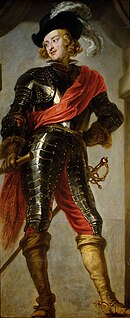
Roermond is a city, municipality, and diocese in the Limburg province of the Netherlands. Roermond is a historically important town on the lower Roer on the east bank of the river Meuse. It received town rights in 1231. Roermond's town centre has become a designated conservation area.

Cardinal-Infante Ferdinand was a Spanish and Portuguese prince, Governor of the Spanish Netherlands, Cardinal of the Holy Catholic Church, Archduke of Austria, Archbishop of Toledo (1619–41), and a general during the Thirty Years' War and the Franco-Spanish War.
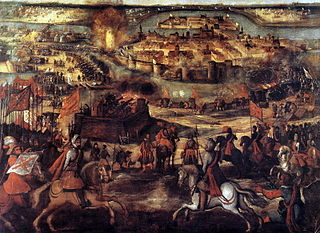
The siege of Maastricht was a battle of the Eighty Years' War which lasted from March 12 – July 1, 1579. The Spanish were victorious.

The Battle of Kallo was a major field battle fought from 20 to 21 June 1638 in and around the forts of Kallo and Verrebroek, located on the left bank of the Scheldt river, near Antwerp, during the second phase of the Eighty Years' War. Following the symbolic recovery of Breda during the 1637 campaign, the Dutch Republic agreed with the French Crown, with whom it had allied in 1635, to besiege a major city in the Spanish Netherlands during the 1638 campaign. The commander of the Dutch States Army, Frederick Henry of Orange, planned an approach over Antwerp from the two sides of the Scheldt. Count William of Nassau-Siegen was entrusted to land in the Spanish-controlled Waasland region, west of Antwerp, to seize the forts of Kallo and Verrebroek, along with several other key fortifications, to invest Antwerp from the west. In the meantime, Frederick Henry would advance on the opposite bank to complete the blockade of the city while the armies of France invaded the Spanish Netherlands from the south to oblige the Spanish Army of Flanders to divide its forces.

The siege of Maastricht was fought between 9 June and 22 August 1632, when the Dutch commander Frederick Henry, Prince of Orange, eventually captured the city from Habsburg forces.

The Battle of Dahlen was fought on April 23, 1568, between a Dutch rebel army led by Jean de Montigny, Lord of Villers, and a Spanish army commanded by Sancho Dávila y Daza. As a part of William of Orange's planned invasion, the Dutch rebels were trying to conquer the town of Roermond when the arrival of the Spanish force compelled them to withdraw. Dávila pursued the retreating force and inflicted a defeat upon Villers near the small town of Dahlen. The survivors of this encounter sought refuge under the walls of Dahlen, where the Spanish infantry finally defeated them. This battle is sometimes considered the official start of the Eighty Years' War.

The Battle of Ekeren, which took place on 30 June 1703, was a battle of the War of the Spanish Succession. The French surrounded the smaller Dutch force, which however managed to break out and retire to safety. The battle had very little strategic effect.
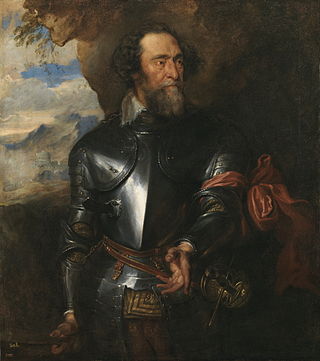
Hendrik van den Bergh, 1573 to 22 May 1638, was a Flemish noble and professional soldier. Hereditary lord of Stevensweert, from 1618 to 1637 he was also stadtholder of Upper Guelders, the only part of Guelders to remain loyal to Habsburg Spain during the Eighty Years War. Known as a brave and resourceful cavalry commander, he spent most of his career with the Spanish Army of Flanders and became its Maestre de campo in 1628. Accused of treachery after the loss of Den Bosch in 1629, he defected to the Dutch Republic following the 1632 Conspiracy of Nobles.

The siege of Schenkenschans was a major siege of the Eighty Years' War. In a successful campaign the Army of Flanders, commanded by Spanish general Cardinal-Infante Ferdinand of Austria, captured Schenkenschans along with a number of important towns, reversing recent Dutch gains and opening the Dutch Republic to a possible invasion. The Dutch Stadtholder, Fredrick Henry, pushed the republic's military efforts to their limit to recapture the fortress of Schenkenschans to counter the threat to the exposed Dutch heartland. He succeeded in doing so after a costly nine month siege.
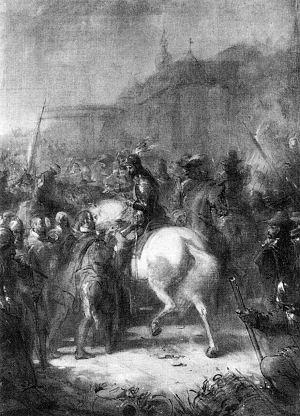
The fourth siege of Breda was an important siege in the Eighty Years' War in which stadtholder Frederick Henry, Prince of Orange retook the city of Breda, which had last changed hands in 1625 when the Spanish general Ambrogio Spinola conquered it for the Spanish Habsburgs. Hereafter, the city would remain in the hands of the Dutch Republic until the end of the war.

The Battle of Les Avins or Avein took place on 20 May 1635, outside the town of Les Avins, near Huy in modern Belgium, then part of the Bishopric of Liège. It was the first major engagement of the 1635 to 1659 Franco-Spanish War, a connected conflict of the Thirty Years' War.

The siege of Leuven was an important siege in the Thirty Years' War in which a Franco-Dutch army under Frederick Henry of Orange and the French Marshals Urbain de Maillé-Brezé and Gaspard III de Coligny, who had invaded the Spanish Netherlands from two sides, laid siege to the city of Leuven, defended by a force of 4,000 comprising local citizen and student militias with Walloons, Germans, Spanish and Irish of the Army of Flanders under Anthonie Schetz, Baron of Grobbendonck. Poor organization and logistics and the spread of sickness among the French, along with the appearance of an Imperial-Spanish relief army of 11,000 under Cardinal-Infante Ferdinand and Ottavio Piccolomini, forced the invading army to lift the siege. This failure allowed the Spanish forces to take the initiative and soon the invaders were forced into a headlong retreat.
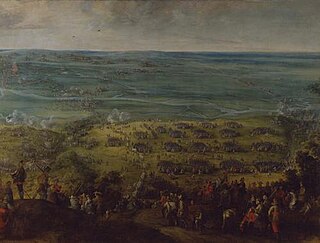
The Crossing of the Somme took place on 5 August 1636 during the Thirty Years' War and the Franco-Spanish War when units of the Spanish Army of Flanders and the Imperial Army under Thomas Francis, Prince of Carignano, lieutenant of the Cardinal-Infante Ferdinand of Austria, crossed the Somme river near Bray-sur-Somme during its offensive in French territory. Despite the fierce resistance of the French army led by Louis de Bourbon, Count of Soissons, the allied troops successfully crossed the river and drove off the French troops along the Oise river, proceeding over the following weeks to invest the important fortress of Corbie, located two leagues upriver of Amiens, which caused a spread of panic among the population of Paris.

The siege of Jülich was a major operation in the second phase of the Eighty Years' War that took place from 5 September 1621 to 3 February 1622. A few months after the Twelve Years' Truce between the Dutch Republic and the Spanish Monarchy expired, the Spanish Army of Flanders, led by the Genoese nobleman Ambrogio Spinola, went on the offensive against the Republic and approached the Rhine river to mask its true intentions: laying siege to the town of Jülich, which the Dutch States Army had occupied in 1610 during the War of the Jülich Succession. Although the capture of the town would not allow for a Spanish invasion of the Republic, its location between the Rhine and Meuse rivers rendered it strategically significant for both sides, given that the United Provinces greatly benefited from the river trade with the neighboring neutral states and Spain was pursuing a strategy of blockading the waterways which flowed across the Republic to ruin its economy.
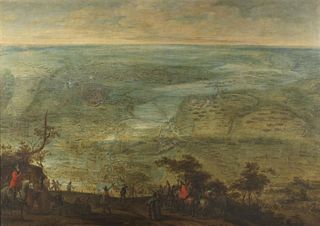
The siege of Saint-Omer was a siege in the Thirty Years' War in which a French army under Gaspard III de Coligny, Maréchal de Châtillon, laid siege to the Flemish city of Saint-Omer, defended by a small garrison in command of Lancelot II Schetz, count of Grobbendonck. Despite several initial successes in the capture of the minor forts around Saint-Omer, on the night of 8/9 June a Spanish relief army under Thomas Francis, Prince of Carignano surprised Châtillon's troops and established a small fort in the middle of the French lines. An entire army corps under Maréchal de La Force was ordered to move towards Saint-Omer to support Châtillon siege, but on 12 July a further Imperial-Spanish force commanded by Ottavio Piccolomini entered Saint-Omer, resolving the French marshals to withdraw.

The siege of Eindhoven, also known as the capture of Eindhoven of 1583, took place between 7 February and 23 April 1583 at Eindhoven, Duchy of Brabant, Spanish Netherlands during the Eighty Years' War and the Anglo-Spanish War (1585–1604). On 7 February 1583 a Spanish force sent by Don Alexander Farnese, Governor-General of the Spanish Netherlands, commanded by Karl von Mansfeld and Claude de Berlaymont, laid siege to Eindhoven, an important and strategic city of Brabant held by Dutch, Scottish, and French soldiers under the States' commander Hendrik van Bonnivet. After three months of siege, and the failed attempts by the States-General to assist Bonnivet's forces, the defenders surrendered to the Spaniards on 23 April.

The siege of Zutphen was an eleven-day siege of the city of Zutphen by Dutch and English troops led by Maurice of Nassau, during the Eighty Years' War and the Anglo–Spanish War. The siege began on 19 May 1591 after a clever ruse by the besiegers. The city was then besieged for eleven days, after which the Spanish garrison surrendered.

The capture of Enschede took place during the Eighty Years' War and the Anglo–Spanish War on 18 and 19 October 1597. A Dutch and English army led by Maurice of Orange took the city after a very short siege and threatening that they would destroy the city. The siege was part of Maurice's campaign of 1597, a successful offensive against the Spaniards during what the Dutch call the Ten Glory Years.
Events in the year 1637 in the Spanish Netherlands and Prince-bishopric of Liège.

The years 1621–1648 constituted the final phase of the Eighty Years' War between the Spanish Empire and the emerging Dutch Republic. It began when the Twelve Years' Truce (1609–1621) expired, and concluded with the Peace of Münster in 1648.



